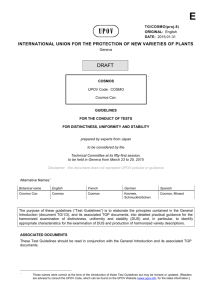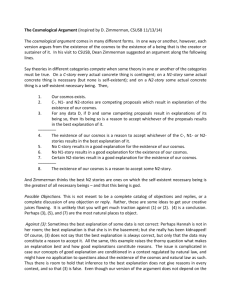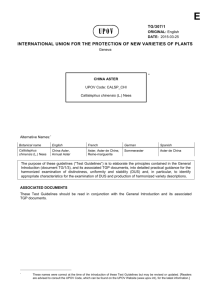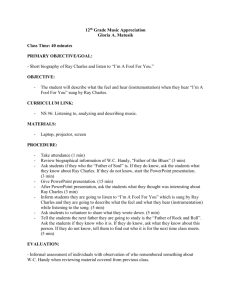Cosmos - TWO
advertisement
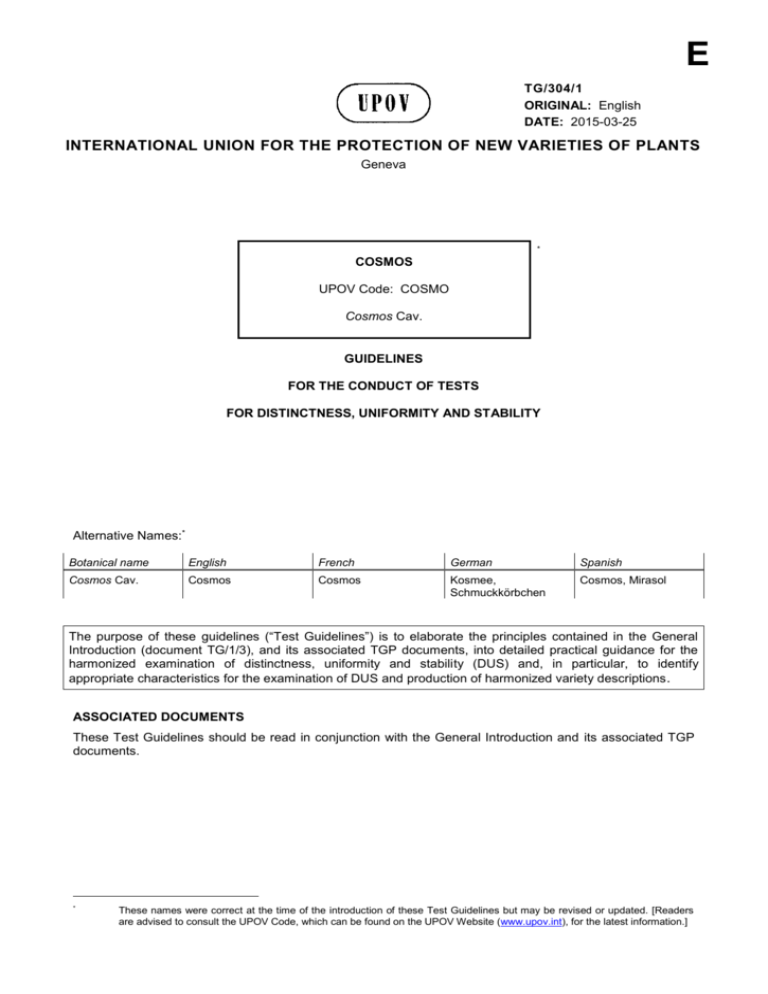
E
TG/304/1
ORIGINAL: English
DATE: 2015-03-25
INTERNATIONAL UNION FOR THE PROTECTION OF NEW VARIETIES OF PLANTS
Geneva
*
COSMOS
UPOV Code: COSMO
Cosmos Cav.
GUIDELINES
FOR THE CONDUCT OF TESTS
FOR DISTINCTNESS, UNIFORMITY AND STABILITY
Alternative Names:*
Botanical name
English
French
German
Spanish
Cosmos Cav.
Cosmos
Cosmos
Kosmee,
Schmuckkörbchen
Cosmos, Mirasol
The purpose of these guidelines (“Test Guidelines”) is to elaborate the principles contained in the General
Introduction (document TG/1/3), and its associated TGP documents, into detailed practical guidance for the
harmonized examination of distinctness, uniformity and stability (DUS) and, in particular, to identify
appropriate characteristics for the examination of DUS and production of harmonized variety descriptions .
ASSOCIATED DOCUMENTS
These Test Guidelines should be read in conjunction with the General Introduction and its associated TGP
documents.
*
These names were correct at the time of the introduction of these Test Guidelines but may be revised or updated. [Readers
are advised to consult the UPOV Code, which can be found on the UPOV Website (www.upov.int), for the latest information.]
TG/304/1
Cosmos, 2015-03-25
-2-
TABLE OF CONTENTS
PAGE
1.
SUBJECT OF THESE TEST GUIDELINES ................................................................................................................ 3
2.
MATERIAL REQUIRED .............................................................................................................................................. 3
3.
METHOD OF EXAMINATION..................................................................................................................................... 3
3.1
3.2
3.3
3.4
3.5
4.
NUMBER OF GROWING CYCLES .............................................................................................................................. 3
TESTING PLACE .................................................................................................................................................... 3
CONDITIONS FOR CONDUCTING THE EXAMINATION .................................................................................................... 3
TEST DESIGN ........................................................................................................................................................ 3
ADDITIONAL TESTS ................................................................................................................................................ 4
ASSESSMENT OF DISTINCTNESS, UNIFORMITY AND STABILITY ...................................................................... 4
4.1 DISTINCTNESS ...................................................................................................................................................... 4
4.2 UNIFORMITY ......................................................................................................................................................... 5
4.3 STABILITY ............................................................................................................................................................. 5
5.
GROUPING OF VARIETIES AND ORGANIZATION OF THE GROWING TRIAL ...................................................... 5
6.
INTRODUCTION TO THE TABLE OF CHARACTERISTICS ..................................................................................... 6
6.1
6.2
6.3
6.4
6.5
CATEGORIES OF CHARACTERISTICS ........................................................................................................................ 6
STATES OF EXPRESSION AND CORRESPONDING NOTES ............................................................................................ 6
TYPES OF EXPRESSION .......................................................................................................................................... 7
EXAMPLE VARIETIES .............................................................................................................................................. 7
LEGEND ............................................................................................................................................................... 7
7.
TABLE OF CHARACTERISTICS/TABLEAU DES CARACTÈRES/MERKMALSTABELLE/TABLA DE
CARACTERES ........................................................................................................................................................... 8
8.
EXPLANATIONS ON THE TABLE OF CHARACTERISTICS ................................................................................... 14
8.1 EXPLANATIONS COVERING SEVERAL CHARACTERISTICS ........................................................................................... 14
8.2 EXPLANATIONS FOR INDIVIDUAL CHARACTERISTICS ................................................................................................. 14
9.
LITERATURE ........................................................................................................................................................... 23
10. TECHNICAL QUESTIONNAIRE ............................................................................................................................... 24
TG/304/1
Cosmos, 2015-03-25
-3-
1.
Subject of these Test Guidelines
These Test Guidelines apply to all varieties of Cosmos Cav..
2.
Material Required
2.1
The competent authorities decide on the quantity and quality of the plant material required for testing
the variety and when and where it is to be delivered. Applicants submitting material from a State other than
that in which the testing takes place must ensure that all customs formalities and phytosanitary requirements
are complied with.
2.2
The material is to be supplied in the form of seeds or young plants.
2.3
The minimum quantity of plant material, to be supplied by the applicant, should be:
seed-propagated varieties: sufficient seeds to produce 50 plants;
vegetatively propagated varieties: 10 young plants.
In the case of seed, the seed should meet the minimum requirements for germination, species and analytical
purity, health and moisture content, specified by the competent authority.
2.4
The plant material supplied should be visibly healthy, not lacking in vigor, nor affected by any
important pest or disease.
2.5
The plant material should not have undergone any treatment which would affect the expression of
the characteristics of the variety, unless the competent authorities allow or request such treatment. If it has
been treated, full details of the treatment must be given.
3.
Method of Examination
3.1
Number of Growing Cycles
The minimum duration of tests should normally be a single growing cycle.
3.2
Testing Place
Tests are normally conducted at one place. In the case of tests conducted at more than one place,
guidance is provided in TGP/9 “Examining Distinctness”.
3.3
Conditions for Conducting the Examination
3.3.1 The tests should be carried out under conditions ensuring satisfactory growth for the expression of
the relevant characteristics of the variety and for the conduct of the examination.
3.3.2 Because daylight varies, color determinations made against a color chart should be made either in a
suitable cabinet providing artificial daylight or in the middle of the day in a room without direct sunlight. The
spectral distribution of the illuminant for artificial daylight should conform with the CIE Standard of Preferred
Daylight D 6500 and should fall within the tolerances set out in the British Standard 950, Part I. These
determinations should be made with the plant part placed against a white background. The color chart and
version used should be specified in the variety description.
3.4
Test Design
3.4.1 Each test should be designed to result in a total of at least 50 plants for seed propagated varieties or
10 plants for vegetatively propagated varieties.
3.4.2 The design of the tests should be such that plants or parts of plants may be removed for
measurement or counting without prejudice to the observations which must be made up to the end of the
growing cycle.
TG/304/1
Cosmos, 2015-03-25
-4-
3.5
Additional Tests
Additional tests, for examining relevant characteristics, may be established.
4.
Assessment of Distinctness, Uniformity and Stability
4.1
Distinctness
4.1.1
General Recommendations
It is of particular importance for users of these Test Guidelines to consult the General Introduction
prior to making decisions regarding distinctness. However, the following points are provided for elaboration
or emphasis in these Test Guidelines.
4.1.2
Consistent Differences
The differences observed between varieties may be so clear that more than one growing cycle is not
necessary. In addition, in some circumstances, the influence of the environment is not such that more than a
single growing cycle is required to provide assurance that the differences observed between varieties are
sufficiently consistent. One means of ensuring that a difference in a characteristic, observed in a growing
trial, is sufficiently consistent is to examine the characteristic in at least two independent growing cycles.
4.1.3
Clear Differences
Determining whether a difference between two varieties is clear depends on many factors, and
should consider, in particular, the type of expression of the characteristic being examined, i.e. whether it is
expressed in a qualitative, quantitative, or pseudo-qualitative manner. Therefore, it is important that users of
these Test Guidelines are familiar with the recommendations contained in the General Introduction prior to
making decisions regarding distinctness.
4.1.4
Number of Plants / Parts of Plants to be Examined
Unless otherwise indicated, for the purposes of distinctness, all observations on single plants should
be made on 20 plants or parts taken from each of 20 plants for seed propagated varieties or 9 plants or parts
taken from each of 9 plants for vegetatively propagated varieties and any other observations made on all
plants in the test, disregarding any off-type plants.
4.1.5
Method of Observation
The recommended method of observing the characteristic for the purposes of distinctness is
indicated by the following key in the second column of the Table of Characteristics (see document TGP/9
“Examining Distinctness”, Section 4 “Observation of characteristics”):
MG:
MS:
VG:
VS:
single measurement of a group of plants or parts of plants
measurement of a number of individual plants or parts of plants
visual assessment by a single observation of a group of plants or parts of plants
visual assessment by observation of individual plants or parts of plants
Type of observation: visual (V) or measurement (M)
“Visual” observation (V) is an observation made on the basis of the expert’s judgment. For the
purposes of this document, “visual” observation refers to the sensory observations of the experts
and, therefore, also includes smell, taste and touch. Visual observation includes observations
where the expert uses reference points (e.g. diagrams, example varieties, side-by-side
comparison) or non-linear charts (e.g. color charts). Measurement (M) is an objective
observation against a calibrated, linear scale e.g. using a ruler, weighing scales, colorimeter,
dates, counts, etc.
TG/304/1
Cosmos, 2015-03-25
-5-
Type of record: for a group of plants (G) or for single, individual plants (S)
For the purposes of distinctness, observations may be recorded as a single record for a group of
plants or parts of plants (G), or may be recorded as records for a number of single, individual
plants or parts of plants (S). In most cases, “G” provides a single record per variety and it is not
possible or necessary to apply statistical methods in a plant-by-plant analysis for the assessment
of distinctness.
In cases where more than one method of observing the characteristic is indicated in the Table of
Characteristics (e.g. VG/MG), guidance on selecting an appropriate method is provided in document TGP/9,
Section 4.2.
4.2
Uniformity
It is of particular importance for users of these Test Guidelines to consult the General Introduction
prior to making decisions regarding uniformity. However, the following points are provided for elaboration or
emphasis in these Test Guidelines:
(a)
seed-propagated varieties
The assessment of uniformity should be according to the recommendations for cross-pollinated
varieties in the General Introduction.
(b)
vegetatively propagated varieties
For the assessment of uniformity, a population standard of 1% and an acceptance probability of at
least 95% should be applied. In the case of a sample size of 10 plants, 1 off-type is allowed.
4.3
Stability
4.3.1 In practice, it is not usual to perform tests of stability that produce results as certain as those of the
testing of distinctness and uniformity. However, experience has demonstrated that, for many types of
variety, when a variety has been shown to be uniform, it can also be considered to be stable.
4.3.2 Where appropriate, or in cases of doubt, stability may be further examined by testing a new seed or
plant stock to ensure that it exhibits the same characteristics as those shown by the initial material supplied.
5.
Grouping of Varieties and Organization of the Growing Trial
5.1
The selection of varieties of common knowledge to be grown in the trial with the candidate varieties
and the way in which these varieties are divided into groups to facilitate the assessment of distinctness are
aided by the use of grouping characteristics.
5.2
Grouping characteristics are those in which the documented states of expression, even where
produced at different locations, can be used, either individually or in combination with other such
characteristics: (a) to select varieties of common knowledge that can be excluded from the growing trial
used for examination of distinctness; and (b) to organize the growing trial so that similar varieties are
grouped together.
5.3
The following have been agreed as useful grouping characteristics:
(a)
(b)
(c)
(d)
Flower head: disc type (characteristic 13)
Flower head: collar segments (characteristic 14)
Ray floret: type (characteristic 19)
Ray floret: main color of inner side (characteristic 25) with the following color groups:
Gr. 1:
white
Gr. 2:
yellow
Gr. 3:
orange
Gr. 4:
pink
Gr. 5:
red
Gr. 6:
purple red
Gr. 7:
brown red
TG/304/1
Cosmos, 2015-03-25
-6-
(e)
Ray floret: secondary color of inner side (characteristic 26) with the following color groups:
Gr. 1:
white
Gr. 2:
yellow
Gr. 3:
orange
Gr. 4:
pink
Gr. 5:
red
Gr. 6:
purple red
Gr. 7:
brown red
5.4
Guidance for the use of grouping characteristics, in the process of examining distinctness, is
provided through the General Introduction and document TGP/9 “Examining Distinctness”.
6.
Introduction to the Table of Characteristics
6.1
Categories of Characteristics
6.1.1
Standard Test Guidelines Characteristics
Standard Test Guidelines characteristics are those which are approved by UPOV for examination of
DUS and from which members of the Union can select those suitable for their particular circumstances.
6.1.2
Asterisked Characteristics
Asterisked characteristics (denoted by *) are those included in the Test Guidelines which are
important for the international harmonization of variety descriptions and should always be examined for DUS
and included in the variety description by all members of the Union, except when the state of expression of a
preceding characteristic or regional environmental conditions render this inappropriate.
6.2
States of Expression and Corresponding Notes
6.2.1 States of expression are given for each characteristic to define the characteristic and to harmonize
descriptions. Each state of expression is allocated a corresponding numerical note for ease of recording of
data and for the production and exchange of the description.
6.2.2 In the case of qualitative and pseudo-qualitative characteristics (see Chapter 6.3), all relevant states
of expression are presented in the characteristic. However, in the case of quantitative characteristics with 5
or more states, an abbreviated scale may be used to minimize the size of the Table of Characteristics. For
example, in the case of a quantitative characteristic with 9 states, the presentation of states of expression in
the Test Guidelines may be abbreviated as follows:
State
small
medium
large
Note
3
5
7
However, it should be noted that all of the following 9 states of expression exist to describe varieties and
should be used as appropriate:
State
very small
very small to small
small
small to medium
medium
medium to large
large
large to very large
very large
Note
1
2
3
4
5
6
7
8
9
TG/304/1
Cosmos, 2015-03-25
-7-
6.2.3 Further explanation of the presentation of states of expression and notes is provided in document
TGP/7 “Development of Test Guidelines”.
6.3
Types of Expression
An explanation of the types of expression of characteristics (qualitative, quantitative and
pseudo-qualitative) is provided in the General Introduction.
6.4
Example Varieties
Where appropriate, example varieties are provided to clarify the states of expression of each
characteristic.
6.5
Legend
(*)
Asterisked characteristic
– see Chapter 6.1.2
QL
QN
PQ
Qualitative characteristic
Quantitative characteristic
Pseudo-qualitative characteristic
– see Chapter 6.3
– see Chapter 6.3
– see Chapter 6.3
MG, MS, VG, VS
– see Chapter 4.1.5
(a)-(c) See Explanations on the Table of Characteristics in Chapter 8.1
(+)
See Explanations on the Table of Characteristics in Chapter 8.2.
TG/304/1
Cosmos/Cosmos/Kosmee/Cosmos, 2015-03-25
-8-
7.
1.
Table of Characteristics/Tableau des caractères/Merkmalstabelle/Tabla de caracteres
VG
Example Varieties
Exemples
Beispielssorten
Variedades ejemplo
Note/
Nota
English
français
deutsch
español
Plant: growth habit
Plante : type de
croissance
Pflanze: Wuchsform
Planta: porte
upright
dressé
aufrecht
erguido
1
semi upright
demi-dressé
halbaufrecht
semierguido
2
spreading
étalé
breitwüchsig
extendido
3
Plant: height
Plante : hauteur
Pflanze: Höhe
Planta: altura
short
basse
niedrig
baja
Sunny Yellow
3
medium
moyenne
mittel
media
Sunset
5
tall
haute
hoch
alta
Sensation Radiance
7
Stem: number of
primary branches
Tige : nombre de
ramifications
primaires
Trieb: Anzahl
Seitentriebe erster
Ordnung
Tallo: número de ramas
primarias
few
petit
gering
bajo
Sunset
3
medium
moyen
mittel
medio
many
grand
groß
alto
Stem: anthocyanin
coloration
Tige : pigmentation
anthocyanique
Trieb:
Anthocyanfärbung
Tallo: pigmentación
antociánica
absent or very weak
absente ou très faible
fehlend oder sehr
gering
weak
faible
medium
(+)
QN
2.
(*)
VG/
MS
QN
3.
VG/
MS
(+)
QN
4.
(*)
VG
QN
5.
VG
QN
5
Sensation Radiance
7
ausente o muy débil
Sunny Yellow
1
gering
débil
Sunrise
2
moyenne
mittel
media
Sunset
3
strong
forte
stark
intensa
Stem: pubescence
Tige : pubescence
Trieb: Behaarung
Tallo: pubescencia
absent or sparse
absente ou peu dense
fehlend oder dünn
ausente o laxa
Sunrise
1
medium
moyenne
mittel
media
Orange Flare
2
dense
dense
dicht
densa
4
3
6.
(*)
(+)
VG/
MS
Leaf: length
Feuille : longueur
Blatt: Länge
Hoja: longitud
QN
(a)
short
courte
kurz
corta
Sunrise
3
medium
moyenne
mittel
media
Sensation Radiance
5
long
longue
lang
larga
7
7.
(*)
(+)
VG/
MS
Leaf: width
Feuille : largeur
Blatt: Breite
Hoja: anchura
QN
(a)
narrow
étroite
schmal
estrecha
Sunrise
3
medium
moyenne
mittel
media
Orange Flare
5
broad
large
breit
ancha
Sensation Radiance
7
TG/304/1
Cosmos/Cosmos/Kosmee/Cosmos, 2015-03-25
-9-
English
français
deutsch
español
Example Varieties
Exemples
Beispielssorten
Variedades ejemplo
Note/
Nota
8.
VG
Leaf: intensity of green Feuille : intensité de
color
la couleur verte
Blatt: Intensität der
Grünfärbung
Hoja: intensidad del
color verde
QN
(a)
light
claire
hell
claro
medium
moyenne
mittel
medio
Sunset
2
dark
foncée
dunkel
oscuro
Orange Flare
3
VG
Leaf: number of lobes
Feuille : nombre de
lobes
Blatt: Anzahl Lappen
Hoja: número de
lóbulos
(a)
absent or very few
nul ou très petit
fehlend oder sehr
gering
ninguno o muy bajo
1
few
petit
gering
bajo
2
medium
moyen
mittel
medio
3
many
grand
hoch
alto
4
very many
très grand
sehr hoch
muy alto
5
VG/
MS
Leaf: width of terminal
lobe (if present)
Feuille : largeur du
lobe terminal (si
présent)
Blatt: Breite des
terminalen Lappens
(falls vorhanden)
Hoja: anchura del
lóbulo terminal (si está
presente)
(a)
narrow
étroit
schmal
estrecho
Sunny Yellow
3
medium
moyen
mittel
medio
Sunrise
5
broad
large
breit
ancho
Peduncle: length
Pédoncule : longueur
Blütenstandstiel:
Länge
Pedúnculo: longitud
short
court
kurz
corto
Sunny Yellow
3
medium
moyen
mittel
medio
Sunrise
5
long
long
lang
largo
Sunset
7
Flower head: attitude
Capitule : port
Blütenstand: Haltung
Capítulo: porte
upwards
vers le haut
aufwärts
ascendente
1
outwards
vers l’extérieur
waagerecht
orientado hacia el exterior
2
downwards
vers le bas
abwärts
orientado hacia abajo
3
Flower head: disc type
Capitule : type de
disque
Blütenstand:
Scheibentyp
Capítulo: tipo de disco
daisy
marguerite
margaritenförmig
margarita
anemone
anémone
anemonenförmig
anémona
Flower head: collar
segments
Capitule : segments
de collerette
Blütenstand:
Kragensegmente
Capítulo: segmentos
del collar
absent
absents
fehlend
ausentes
present
présents
vorhanden
presentes
9.
1
(+)
QN
10.
(+)
QN
11.
VG/
MS
QN
12.
VG
7
(+)
QN
13.
(*)
(+)
VG
QL
14.
(*)
(+)
QL
VG
1
Bridal Bouquet COS
2
1
Red Illusion
9
TG/304/1
Cosmos/Cosmos/Kosmee/Cosmos, 2015-03-25
- 10 -
15.
(*)
(+)
VG/
MS
QN
16.
(*)
(+)
VG/
MS
QN
17.
VG/
MS
18.
(*)
(+)
VG/
MS
QN
19.
(*)
(+)
PQ
VG
Note/
Nota
français
deutsch
español
Flower head: number
of ray florets
Capitule : nombre de
fleurons
Blütenstand: Anzahl
Zungenblüten
Capítulo: número de
flores liguladas
very few
très petit
sehr gering
muy bajo
few
petit
gering
bajo
medium
moyen
mittel
medio
many
grand
hoch
alto
very many
très grand
sehr hoch
muy alto
Flower head: diameter
Capitule : diamètre
Blütenstand:
Durchmesser
Capítulo: diámetro
small
petit
klein
pequeño
medium
moyen
mittel
medio
large
grand
groß
grande
Flower head: disc
diameter
Capitule : diamètre du
disque
Blütenstand:
Scheibendurchmesser
Capítulo: diámetro del
disco
very small
très petit
sehr klein
muy pequeño
small
petit
klein
pequeño
medium
moyen
mittel
medio
large
grand
groß
grande
very large
très grand
sehr groß
muy grande
Flower head: disc
diameter relative to
flower head diameter
Capitule : diamètre du
disque par rapport au
diamètre du capitule
Blütenstand:
Scheibendurchmesser im
Verhältnis zum
Durchmesser des
Blütenstands
Capítulo: diámetro del
disco con respecto al
diámetro del capítulo
very small
très petit
sehr klein
muy pequeño
small
petit
klein
pequeño
medium
moyen
mittel
medio
large
grand
groß
grande
very large
très grand
sehr groß
muy grande
Ray floret: type
Fleuron : type
Zungenblüte: Typ
Flor ligulada: tipo
ligulate
ligulé
zungenförmig
loriforme
1
ligulate and tubular
ligulé et tubulaire
zungenförmig und
röhrenförmig
loriforme y tubular
2
tubular
tubulaire
röhrenförmig
tubular
3
(+)
QN
Example Varieties
Exemples
Beispielssorten
Variedades ejemplo
English
1
Sunset
2
3
Double Click
4
5
Sunrise
3
5
Sensation Radiance
7
1
Sensation Radiance
2
3
Bridal Bouquet COS
4
5
1
Sensation Radiance
2
3
Bridal Bouquet COS
4
5
TG/304/1
Cosmos/Cosmos/Kosmee/Cosmos, 2015-03-25
- 11 -
20.
Example Varieties
Exemples
Beispielssorten
Variedades ejemplo
Note/
Nota
English
français
deutsch
español
VG
Ray floret: longitudinal
axis
Fleuron : axe
longitudinal
Zungenblüte:
Längsachse
Flor ligulada: eje
longitudinal
(b)
strongly incurved
fortement incurvé
stark aufgebogen
muy incurvado
1
moderately incurved
moyennement incurvé
mäßig aufgebogen
moderadamente
incurvado
2
weakly incurved
faiblement incurvé
schwach aufgebogen
débilmente incurvado
3
straight
droit
gerade
recto
4
weakly reflexed
faiblement réfléchi
schwach
zurückgebogen
débilmente reflexo
5
moderately reflexed
moyennement réfléchi
mäßig zurückgebogen
moderadamente reflexo
6
strongly reflexed
fortement réfléchi
stark zurückgebogen
muy reflexo
7
VG
Ray floret: curved part
of axis
Fleuron : partie
incurvée de l’axe
Zungenblüte:
gebogener Teil der
Längsachse
Flor ligulada: parte
curvada del eje
(b)
none
aucune
keiner
ninguna
1
tip
extrémité
die Spitze
punta
2
distal half
moitié distale
die distale Hälfte
mitad distal
3
distal three quarters
trois quarts distaux
das distale Dreiviertel
tres cuartos distales
4
entire length
longueur toute entière
die gesamte Länge
totalidad
5
(+)
QN
21.
(+)
PQ
22.
(*)
(+)
VG/
MS
Ray floret: length
Fleuron : longueur
Zungenblüte: Länge
Flor ligulada: longitud
QN
(b)
short
court
kurz
corta
medium
moyen
mittel
media
long
long
lang
larga
Sunset
3
5
Sensation Radiance
7
23.
(*)
(+)
VG/
MS
Ray floret: width
Fleuron : largeur
Zungenblüte: Breite
Flor ligulada: anchura
QN
(b)
narrow
étroit
schmal
estrecha
Sunset
3
medium
moyen
mittel
media
Sensation Radiance
5
broad
large
breit
ancha
7
24.
(*)
(+)
VG/
MS
Ray floret: ratio
length/width
Fleuron : rapport
longueur/largeur
Zungenblüte:
Verhältnis
Länge/Breite
Flor ligulada: relación
longitud/anchura
QN
(b)
low
bas
klein
baja
medium
moyen
mittel
media
Sensation Radiance
5
high
élevé
groß
alta
Happy Ring
7
25.
(*)
VG
Ray floret: main color
of inner side
Fleuron : couleur
principale de la face
interne
Zungenblüte:
Hauptfarbe der
Innenseite
Flor ligulada: color
principal de la cara
interna
PQ
(b)
(c)
RHS Colour Chart
(indicate reference
number)
Code RHS des
couleurs (indiquer le
numéro de référence)
RHS-Farbkarte
(Nummer angeben)
Carta de colores RHS
(indíquese el número de
referencia)
3
TG/304/1
Cosmos/Cosmos/Kosmee/Cosmos, 2015-03-25
- 12 -
English
français
deutsch
español
Example Varieties
Exemples
Beispielssorten
Variedades ejemplo
Note/
Nota
26.
(*)
VG
Ray floret: secondary
color of inner side
Fleuron : couleur
secondaire de la face
interne
Zungenblüte:
Sekundärfarbe der
Innenseite
Flor ligulada: color
secundario de la cara
interna
PQ
(b)
(c)
RHS Colour Chart
(indicate reference
number)
Code RHS des
couleurs (indiquer le
numéro de référence)
RHS-Farbkarte
(Nummer angeben)
Carta de colores RHS
(indíquese el número de
referencia)
27.
(*)
(+)
VG
Ray floret: distribution
of secondary color of
inner side
Fleuron : distribution
de la couleur
secondaire de la face
interne
Zungenblüte:
Verteilung der
Sekundärfarbe der
Innenseite
Flor ligulada:
distribución del color
secundario en la cara
interna
PQ
(b)
none
aucune
keine
inexistente
1
(c)
basal zone
zone basale
in der basalen Zone
zona basal
2
basal quarter
quart basal
im basalen Viertel
cuarto basal
3
basal half
moitié basale
in der basalen Hälfte
mitad basal
4
distal half
moitié distale
in der distalen Hälfte
mitad distal
5
distal quarter
quart distal
im distalen Viertel
cuarto distal
6
tip
extrémité
an der Spitze
punta
7
band
bande
als Band
banda
8
marginal zone
zone marginale
in der Randzone
zona del borde
9
central zone
zone centrale
in der Mittelzone
zona central
10
throughout
partout
überall
totalidad
11
28.
VG
Ray floret: pattern of
secondary color of
inner side
Fleuron : répartition
de la couleur
secondaire de la face
interne
Zungenblüte: Muster
der Sekundärfarbe
der Innenseite
Flor ligulada:
distribución del color
secundario de la cara
interna
PQ
(b)
solid or nearly solid
uniforme ou presque
durchgefärbt oder fast
durchgefärbt
uniforme o casi uniforme
1
(c)
flushed
traces diffuses
geflammt
rubor
2
striped
striée
gestreift
estriado
3
29.
VG
Ray floret: tertiary
color of inner side
Fleuron : couleur
tertiaire de la face
interne
Zungenblüte:
Tertiärfarbe der
Innenseite
Flor ligulada: color
terciario de la cara
interna
PQ
(b)
(c)
RHS Colour Chart
(indicate reference
number)
Code RHS des
couleurs (indiquer le
numéro de référence)
RHS-Farbkarte
(Nummer angeben)
Carta de colores RHS
(indíquese el número de
referencia)
TG/304/1
Cosmos/Cosmos/Kosmee/Cosmos, 2015-03-25
- 13 -
30.
Note/
Nota
français
deutsch
español
VG
Ray floret: distribution
of tertiary color of
inner side
Fleuron : distribution
de la couleur tertaire
de la face interne
Zungenblüte:
Verteilung der
Tertiärfarbe der
Innenseite
Flor ligulada:
distribución del color
terciario en la cara
interna
(b)
none
aucune
keine
inexistente
1
(c)
basal zone
zone basale
in der basalen Zone
zona basal
2
basal quarter
quart basal
im basalen Viertel
cuarto basal
3
basal half
moitié basale
in der basalen Hälfte
mitad basal
4
distal half
moitié distale
in der distalen Hälfte
mitad distal
5
distal quarter
quart distal
im distalen Viertel
cuarto distal
6
tip
extrémité
an der Spitze
punta
7
band
bande
als Band
banda
8
marginal zone
zone marginale
in der Randzone
zona del borde
9
central zone
zone centrale
in der Mittelzone
zona central
10
throughout
partout
überall
totalidad
11
(+)
PQ
Example Varieties
Exemples
Beispielssorten
Variedades ejemplo
English
31.
VG
Ray floret: pattern of
tertiary color of inner
side
Fleuron : répartition
de la couleur tertiaire
de la face interne
Zungenblüte:
Verteilung der
Tertiärfarbe der
Innenseite
Flor ligulada:
distribución del color
terciario de la cara
interna
PQ
(b)
solid or nearly solid
uniforme ou presque
durchgefärbt oder fast
durchgefärbt
uniforme o casi uniforme
1
(c)
flushed
traces diffuses
geflammt
rubor
2
striped
striée
gestreift
estriado
3
32.
(*)
VG
Ray floret: main color
of outer side
Fleuron : couleur
principale de la face
externe
Zungenblüte:
Hauptfarbe der
Außenseite
Flor ligulada: color
principal de la cara
externa
PQ
(b)
(c)
RHS Colour Chart
(indicate reference
number)
Code RHS des
couleurs (indiquer le
numéro de référence)
RHS-Farbkarte
(Nummer angeben)
Carta de colores RHS
(indíquese el número de
referencia)
33.
(*)
(+)
VG
Ray floret: incisions of
apex
Fleuron : incisions de
l’apex
Zungenblüte:
Einschnitte der Spitze
Flor ligulada: incisiones
del ápice
QN
(b)
absent or very shallow
absentes ou très faibles fehlend or sehr flach
ausentes o muy poco
profundas
1
shallow
faibles
flach
poco profundas
3
medium
moyennes
mittel
de profundidad media
deep
profondes
tief
profundas
Disc: main color
Disque : couleur
principale
Scheibe: Hauptfarbe
Disco: color principal
RHS Colour Chart
(indicate reference
number)
Code RHS des
couleurs (indiquer le
numéro de référence)
RHS-Farbkarte
(Nummer angeben)
Carta de colores RHS
(indíquese el número de
referencia)
34.
(*)
(+)
PQ
VG
Sensation Radiance,
Sunset
5
7
TG/304/1
Cosmos, 2015-03-25
- 14 -
8.
Explanations on the Table of Characteristics
8.1
Explanations covering several characteristics
Characteristics containing the following key in the second column of the Table of Characteristics should be
examined as indicated below:
Unless otherwise indicated, all observations should be made at the time of full flowering.
(a)
(b)
(c)
8.2
Observations on the leaf should be made on the leaves from the middle third of the stem.
Observations on the ray floret should be made on the outermost row of ray florets.
The main color is the color with the largest surface area, the secondary color is the color with
the second largest surface area, and the tertiary color is the color with the third largest
surface area. In cases where the area of the main and secondary colors are too similar to
reliably decide which color has the largest area, the darkest color is considered to be the
main color. In cases where the area of the secondary and tertiary colors are too similar to
reliably decide which color has the second largest area, the darkest color is considered to be
the secondary color.
Explanations for individual characteristics
Ad. 1: Plant: growth habit
1
upright
2
semi upright
3
spreading
TG/304/1
Cosmos, 2015-03-25
- 15 -
Ad. 3: Stem: number of primary branches
The primary branches are indicated by arrows in the following diagram.
5
6
4
3
1
2
Ad. 6: Leaf: length
Ad. 7: Leaf: width
Leaf:
length
Leaf: width
Leaf:
length
Leaf: width
TG/304/1
Cosmos, 2015-03-25
- 16 -
Ad. 9: Leaf: number of lobes
For varieties that are very polymorphic the observation should consider the most frequent number of
lobes.
1
absent or very few
2
few
3
medium
4
many
5
very many
TG/304/1
Cosmos, 2015-03-25
- 17 -
Ad. 10: Leaf: width of terminal lobe (if present)
Ad. 12: Flower head: attitude
1
upwards
2
outwards
3
downwards
Ad. 13: Flower head: disc type
1
daisy
2
anemone
TG/304/1
Cosmos, 2015-03-25
- 18 -
Ad. 14: Flower head: collar segments
collar segments
Ad. 15: Flower head: number of ray florets
In varieties with collar segments the number of ray florets should be observed excluding the collar
segments.
Ad. 16: Flower head: diameter
Ad. 17: Flower head: disc diameter
Ad. 18: Flower head: disc diameter relative to flower head diameter
a: flower head diameter
b: disc diameter
b
b
a
a
Ad. 17: Flower head: disc diameter
In varieties with collar segments the disc diameter should be observed excluding the collar
segments.
TG/304/1
Cosmos, 2015-03-25
- 19 -
Ad. 19: Ray floret: type
1
ligulate
3
tubular
Ad. 20: Ray floret: longitudinal axis
1
strongly incurved
5
weakly reflexed
2
moderately incurved
6
moderately reflexed
3
weakly incurved
7
strongly refelxed
4
straight
TG/304/1
Cosmos, 2015-03-25
- 20 -
Ad. 21: Ray floret: curved part of axis
1
none
2
tip
3
distal half
4
distal three quarter
5
entire length
Ad. 22: Ray floret: length
Ad. 23: Ray floret: width
Ray floret: length
Ray floret:
width
Ray floret: length
Ray floret:
width
TG/304/1
Cosmos, 2015-03-25
- 21 -
Ad. 24: Ray floret: ratio length/width
3
low
5
medium
7
high
Ad. 27: Ray floret: distribution of secondary color of inner side
Ad. 30: Ray floret: distribution of tertiary color of inner side
2
basal zone
7
tip
3
basal quarter
8
band
4
basal half
9
marginal zone
5
distal half
10
central zone
6
distal quarter
11
throughout
TG/304/1
Cosmos, 2015-03-25
- 22 -
Ad. 33: Ray floret: incisions of apex
3
shallow
5
medium
7
deep
Ad. 34: Disc: main color
The color of disc should be observed just before anther dehiscence for daisy type, and at the time of
full flowering for anemone type.
TG/304/1
Cosmos, 2015-03-25
- 23 -
9.
Literature
Bailey, L. H., Bailey, E. Z.: 1976: Hortus Third, A Concise Dictionary of Plants Cultivated in the United States
and Canada. Macmillan. NewYork, US, p. 321
Huxley, A. (ed.), Griffiths, M.(ed.), Levy, M.(ed.),1999: The Royal Horticultural Society Dictionary of
Gardening. Volume 1. A to C. Macmillan reference Ltd. London, GB, pp. 738-739
Everett, T. H., 1981: New York Botanical Garden Illustrated Encyclopedia of Horticulture. Garland Publishing.
New York, US, pp. 890-891
Tsukamoto, Y., 1994: The Grand Dictionary of Horticulture Volume 1. The Shogakukan Ltd., Tokyo, JP,
pp. 860-862
TG/304/1
Cosmos, 2015-03-25
- 24 -
10.
Technical Questionnaire
TECHNICAL QUESTIONNAIRE
Page {x} of {y}
Reference Number:
Application date:
(not to be filled in by the applicant)
TECHNICAL QUESTIONNAIRE
to be completed in connection with an application for plant breeders’ rights
1.
Subject of the Technical Questionnaire
1.1
Genus
1.2
Species
Cosmos Cav.
(please complete)
1.3
2.
Common name
Cosmos
Applicant
Name
Address
Telephone No.
Fax No.
E-mail address
Breeder (if different from
applicant)
3.
Proposed denomination and breeder’s reference
Proposed denomination
(if available)
Breeder’s reference
TG/304/1
Cosmos, 2015-03-25
- 25 -
TECHNICAL QUESTIONNAIRE
#4.
Page {x} of {y}
Reference Number:
Information on the breeding scheme and propagation of the variety
4.1
Breeding scheme
Variety resulting from:
4.1.1
Crossing
(a)
controlled cross
(please state parent varieties)
(…………………..…………………………)
female parent
(b)
#
x
]
(……………..…………..………………..…)
male parent
partially known cross
(please state known parent variety(ies))
(…………………..……………………....…)
female parent
(c)
x
[
[
]
(……………..………………..…………..…)
male parent
unknown cross
[
]
4.1.2
Mutation
(please state parent variety)
[
]
4.1.3
Discovery and development
(please state where and when discovered and how developed)
[
]
4.1.4
Other
(please provide details)
[
]
Authorities may allow certain of this information to be provided in a confidential section of the Technical Questionnaire.
TG/304/1
Cosmos, 2015-03-25
- 26 -
TECHNICAL QUESTIONNAIRE
4.2
Page {x} of {y}
Reference Number:
Method of propagating the variety
4.2.1
Seed-propagated varieties
(a)
(b)
(c)
(d)
4.2.2
4.2.3
Self-pollination
Cross-pollination
(i) population
(ii) synthetic variety
Hybrid
Other
(please provide details)
[ ]
[
[
[
[
]
]
]
]
Vegetative propagation
(a)
cuttings
[ ]
(b)
in vitro propagation
[ ]
(c)
other (state method)
[ ]
Other
(please provide details)
[ ]
TG/304/1
Cosmos, 2015-03-25
- 27 -
TECHNICAL QUESTIONNAIRE
5.
Page {x} of {y}
Characteristics of the variety to be indicated (the number in brackets refers to the corresponding characteristic
in Test Guidelines; please mark the note which best corresponds).
Characteristics
5.1
(1)
5.2
(13)
Reference Number:
Example Varieties
Plant: growth habit
upright
1[ ]
semi upright
2[ ]
spreading
3[ ]
Flower head: disc type
daisy
anemone
5.3
(14)
1[ ]
Bridal Bouquet COS
present
5.5 (i)
(25)
2[ ]
Flower head: collar segments
absent
5.4
(19)
Note
1[ ]
Red Illusion
9[ ]
Ray floret: type
ligulate
1[ ]
ligulate and tublar
2[ ]
tubular
3[ ]
Ray floret: main color of inner side
RHS Colour Chart (indicate reference number)
5.5 (ii)
(25)
Ray floret: main color of inner side
white
1[ ]
yellow
2[ ]
orange
3[ ]
pink
4[ ]
red
5[ ]
purple red
6[ ]
brown red
7[ ]
other color (indicate)
8[ ]
TG/304/1
Cosmos, 2015-03-25
- 28 -
TECHNICAL QUESTIONNAIRE
Page {x} of {y}
Characteristics
5.6 (i)
(26)
Reference Number:
Example Varieties
Note
Ray floret: secondary color of inner side
RHS Colour Chart (indicate reference number)
5.6 (ii)
(26)
Ray floret: secondary color of inner side
white
1[ ]
yellow
2[ ]
orange
3[ ]
pink
4[ ]
red
5[ ]
purple red
6[ ]
brown red
7[ ]
other color (indicate)
8[ ]
TG/304/1
Cosmos, 2015-03-25
- 29 -
TECHNICAL QUESTIONNAIRE
6.
Page {x} of {y}
Reference Number:
Similar varieties and differences from these varieties
Please use the following table and box for comments to provide information on how your candidate variety differs
from the variety (or varieties) which, to the best of your knowledge, is (or are) most similar. This information may
help the examination authority to conduct its examination of distinctness in a more efficient way.
Denomination(s) of
variety(ies) similar to your
candidate variety
Characteristic(s) in which
your candidate variety
differs from the similar
variety(ies)
Describe the expression of
the characteristic(s) for the
similar variety(ies)
Describe the expression of
the characteristic(s) for
your candidate variety
Example
Plant: growth habit
upright
semi upright
Comments:
TG/304/1
Cosmos, 2015-03-25
- 30 -
TECHNICAL QUESTIONNAIRE
Page {x} of {y}
Reference Number:
#7.
Additional information which may help in the examination of the variety
7.1
In addition to the information provided in sections 5 and 6, are there any additional characteristics which may
help to distinguish the variety?
Yes
[ ]
No
[ ]
(If yes, please provide details)
7.2
Are there any special conditions for growing the variety or conducting the examination?
Yes
[ ]
No
[ ]
(If yes, please provide details)
7.3
Other information
7.4
A representative color photograph of the variety displaying its main distinguishing feature(s), should
accompany the Technical Questionnaire. The photograph will provide a visual illustration of the candidate variety
which supplements the information provided in the Technical Questionnaire.
The key points to consider when taking a photograph of the candidate variety are:
Indication of the date and geographic location
Correct labeling (breeder’s reference)
Good quality printed photograph (minimum 10 cm x 15 cm) and/or sufficient resolution electronic format
version (minimum 960 x 1280 pixels)
Further guidance on providing photographs with the Technical Questionnaire is available in document TGP/7
“Development of Test Guidelines”, Guidance Note 35 (http://www.upov.int/tgp/en/).
[The link provided may be deleted by members of the Union when developing authorities’ own test guidelines.]
8.
Authorization for release
(a)
Does the variety require prior authorization for release under legislation concerning the protection of
the environment, human and animal health?
Yes
(b)
[ ]
No
[ ]
Has such authorization been obtained?
Yes
[ ]
No
[ ]
If the answer to (b) is yes, please attach a copy of the authorization.
#
Authorities may allow certain of this information to be provided in a confidential section of the Technical Questionnaire.
TG/304/1
Cosmos, 2015-03-25
- 31 -
TECHNICAL QUESTIONNAIRE
9.
Page {x} of {y}
Reference Number:
Information on plant material to be examined or submitted for examination
9.1
The expression of a characteristic or several characteristics of a variety may be affected by factors, such as
pests and disease, chemical treatment (e.g. growth retardants or pesticides), effects of tissue culture, different
rootstocks, scions taken from different growth phases of a tree, etc.
9.2
The plant material should not have undergone any treatment which would affect the expression of the
characteristics of the variety, unless the competent authorities allow or request such treatment. If the plant material
has undergone such treatment, full details of the treatment must be given. In this respect, please indicate below, to
the best of your knowledge, if the plant material to be examined has been subjected to:
(a)
Microorganisms (e.g. virus, bacteria, phytoplasma)
Yes [ ]
No [ ]
(b)
Chemical treatment (e.g. growth retardant, pesticide)
Yes [ ]
No [ ]
(c)
Tissue culture
Yes [ ]
No [ ]
(d)
Other factors
Yes [ ]
No [ ]
Please provide details for where you have indicated “yes”.
......................................................................................................................................................................
10.
I hereby declare that, to the best of my knowledge, the information provided in this form is correct:
Applicant’s name
Signature
Date
[End of document]
